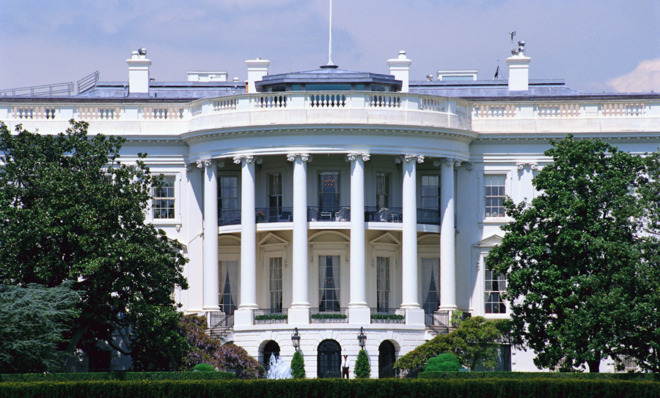Did the Secret Service drop the ball in 2011?
An internal document sheds light on a scary night at the White House


On November 11, 2011, Oscar Ortega-Hernandez opened the driver's side window of his S.U.V. and fired high-velocity rounds from a semi-automatic rifle at the White House as he drove past the complex on Constitution Avenue. This week, The Washington Post published an article suggesting that the Secret Service ignored contemporaneous reports that his bullets struck the executive mansion. At Tuesday's hearing, director Julia Pierson struggled to explain why it took agents four days to discover that, yes, the White House was Ortega-Hernandez's target.
An internal timeline of the Secret Service's response obtained by TheWeek.com answers some questions raised by the Post article, and poses a few of its own. The timeline, which is not classified, was given to TheWeek.com by an agency supporter who believes that the the press account does not give the Secret Service credit for responding properly. It includes events the Secret Service deemed to be significant to the investigation at the time.
At 8:52 p.m. on that November night in 2011, an officer at the White House vehicle access post at 15th and E streets — about 100 yards away, diagonally and to the east, from the executive mansion — reported hearing several gunshots. This triggered an immediate reaction from officers and emergency response teams.
The Week
Escape your echo chamber. Get the facts behind the news, plus analysis from multiple perspectives.

Sign up for The Week's Free Newsletters
From our morning news briefing to a weekly Good News Newsletter, get the best of The Week delivered directly to your inbox.
From our morning news briefing to a weekly Good News Newsletter, get the best of The Week delivered directly to your inbox.
According to The Washington Post, a supervisor then took to the radio to say that the shots were nothing more than the backfire of a truck. The internal report does not include this statement. It is not clear whether other officers had come to the same conclusion. Still, the Post reported, some officers slowed their response when the supervisor seemed to cast doubt on the initial report of gunshots.
Within seconds, though, another officer, Walter Johnson, who was sitting in an unmarked SUV several hundred yards to the South, at 16th and Constitution Avenue, confirmed that the sounds he had heard were gunshots. He spoke to a witness, who reported seeing a black Cadillac firing in the direction of a yellow vehicle that was next to it. On Twitter, a witness said that the shots were fired in the direction of the White House — and then amended this report to say that the shots were fired "not directly at the White House."
What happened next is not clear. Officer Carrie Johnson, standing underneath the Truman Balcony, heard the radio call about shots being fired at the same time as some debris seemed to tumble down. Neither the Post nor the internal chronology compiled by the Secret Service suggests that she radioed in this information.
Instead, Johnson reacted as she was trained to: She opened a nearby gun-box, which sent an automatic alert to the Secret Service's Joint Operations Center, and took cover, along with as several other officers, including an Emergency Response Team with heavy weapons.
A free daily email with the biggest news stories of the day – and the best features from TheWeek.com
The Park Police discovered Ortega-Hernandez's vehicle a minute later. He had fled, but he left his gun in the vehicle with spent shell casings. Clearly, something had happened. The Service set up a Command Post near the scene.
The internal account does not say when Johnson first mentioned hearing debris falling to a supervisor a few minutes later. But someone did — because 18 minutes after the first report of shots, officers made a cursory inspection of the grounds to see if there were any bullets, damage, or shell casings. They shined flashlights onto the windows of the second floor of the residence and saw nothing. The next morning, after the sun came up, the assistant director for investigations, Keith Prewett, was briefed on the results of a second canvass. There was no visible damage. But supervisors did not ask for a cherry picker to meticulously search the parts of the complex not visible from the ground or the roof.
Why were the special agents inside the White House not alerted on their own frequency? At the JOC, at the "Horsepower" command post in the West Wing, and at the Flagship U.D. post, both frequencies were monitored 24/7 by agents and officers sitting together. The most likely explanation: caution and confusion. I suspect that there was a reluctance to overreact when the scene seemed to settle down, when an abandoned car had been found with a weapon, after only a brief burst of gunshots. I suspect that the Uniformed Division supervisors did not want to startle Sasha Obama and her grandmother, Marian Robinson, and evacuate her to a hard room unless she was in genuine danger. What scientists call the "availability heuristic" almost certainly biased the initial responses of the officers and agents working the command posts — they had no idea that shots had hit the White House initially, and when, maybe ten minutes later, Carrie Johnson's ear-witness report was circulated, the emergency was over — and of course, by that time, the detail had been notified. Agents would note that no alarms had been triggered from glass-breaking sensors attached to a number of windows at the residence.
The next morning, the "gang-related shooting" idea had taken hold. Investigators knew Ortega-Hernandez's name by this point but had yet to interview anyone who could speak to his motive. Officer Johnson would later tell an investigator that she was too afraid to challenge this conclusion, even though she knew what she saw and heard. Several years later, Johnson's claim bewildered several supervisors: There would not be any reason, they said, to doubt her; even assuming the worst of motivations, there would be no reason to cover up the possibility of an actual attack if there was even a remote chance that someone would find evidence of it later. But Johnson's concern was different: She had already told her supervisors what she heard. They did not seem to believe her. The message had already been sent.
Four days later, when Paula Reid, a deputy special agent in charge of the president's detail, was notified by a housekeeper about spent bullet fragments on the Truman balcony, more than two dozen Secret Service agents were already on the hunt for Ortega-Hernandez. That same day, a Secret Service agent who interviewed his family members learned that Ortega-Hernandez frequented a motel in Indiana, Pennsylvania. It was placed immediately under surveillance and Ortega was arrested the next day.
All of this was reported in the press at the time. The Post's account had three new pieces of information: the whistleblower, Johnson, who had direct evidence that the White House had been under attack, was ignored; the tale of the supervisor who confused officers by attributing the gunshots to a car backfire; and the fact that agents inside the residence weren't immediately informed of the incident.
The evidence provided by the Post, as well as the documents seen by TheWeek.com, show that the Johnson did not immediately tell anyone about falling debris. It suggests that the confusion created by the supervisor on duty lasted seconds. It confirms that the Secret Service twice canvassed the area around the residence, once at night, and once the next morning, based (apparently) on Johnson's report and others.
These facts do not exculpate the Secret Service. They point to basic problems with radio procedures, jurisdictional confusion, and a young officer's lack of confidence in her bosses' judgments. But they also show solid investigative work and back up the Secret Service's contention that they took the incident seriously.
Marc Ambinder is TheWeek.com's editor-at-large. He is the author, with D.B. Grady, of The Command and Deep State: Inside the Government Secrecy Industry. Marc is also a contributing editor for The Atlantic and GQ. Formerly, he served as White House correspondent for National Journal, chief political consultant for CBS News, and politics editor at The Atlantic. Marc is a 2001 graduate of Harvard. He is married to Michael Park, a corporate strategy consultant, and lives in Los Angeles.
-
 Pakistan: Trump’s ‘favourite field marshal’ takes charge
Pakistan: Trump’s ‘favourite field marshal’ takes chargeIn the Spotlight Asim Munir’s control over all three branches of Pakistan’s military gives him ‘sweeping powers’ – and almost unlimited freedom to use them
-
 Codeword: December 6, 2025
Codeword: December 6, 2025The daily codeword puzzle from The Week
-
 Crossword: December 6, 2025
Crossword: December 6, 2025The daily crossword from The Week
